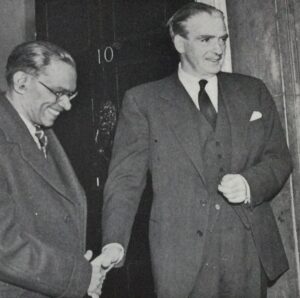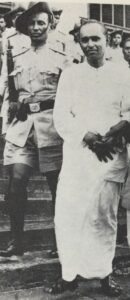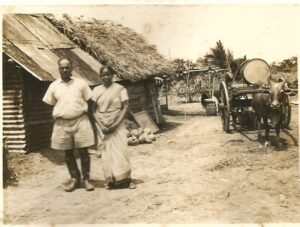– Hanged 60 years ago
by Sachi Sri Kantha, June 9, 2022

Bandaranaike (lt) visiting with the then British Prime minister Sir Anthony Eden, (Nov. 1956)
On July 4, 1962, Talduwa Somarama Thero was hanged at the Welikade prison, Colombo. His crime: He was framed as the sole assassin of S.W.R.D. Bandaranaike, the then Prime Minister of Ceylon, on September 25, 1959. This tragic shooting event happened at the then prime minister’s private residence in Rosemead Place, Colombo.
I was 6 years old then. Bandaranaike and Somarama Thero were the two public names, which got registered in my mind on that day, when I lived at my maternal grandfather Arumugam Thiyagarajah’s farm at Thachadampan village, located on the Mankulam – Mullaitivu trunk road. On that day, my grandpa came home in the evening to tell the news ‘Bandararanaika vai suddudanam – oru Bhikku. Avanrai payar Somarama vam.’ [One bhikku had shot Bandaranaike. His name was Somarama Thero] to us. In fact, apart from the two names of the victim and the assassin, bhikku (originally, a Pali language word for Buddhist priest) was the first Sinhalese word I came to learn then.
To mark its 50th anniversary, previously in this site, I had reviewed Bandaranaike assassination in three parts (Sept. 26, 2009, Oct. 3, 2009, Oct. 10, 2009). The links to these reports are as follows:
https://sangam.org/2009/09/Bandaranaike_Assassination.php?uid=3691
https://sangam.org/2009/10/Bandaranaike_Assassinations.php
https://sangam.org/2009/10/Bandaranaike_Assassination_3.php?uid=3710

Somarama Thero (rt) in handcuffs
For almost 60 years, not a SINGLE academic paper was published specifically on this Bandaranaike assassination, though it has been passingly mentioned in many political science papers and in a few covering Bandaranaike’s career. To mark the hanging of Rev. Somarama Thero, I published a research paper from the forensic medicine angle, in the International Medical Journal (Tokyo). Its title is, ‘Forensic aspects on the 1959 assassination of an Asian prime minister by a Buddhist physician monk’, expanding the 2nd part of my 2009 report. For interested readers, the link for a pdf file of this paper is as follows:
https://seronjihou.files.wordpress.com/2022/02/291053.pdf
Forensic Aspects of the 1959 Assasination of Banadaranaike by Sri Kantha
While many of the ‘assassination papers’ in academic journals focus on the victim’s injury and death, in this paper, I focused on the assassin for one specific reason. In 1960s and 1970s while I grew up and began to read books on contemporary Sri Lanka, Somarama’s name was obscured. He was simply mentioned as ‘a bhikku’ (Buddhist monk). Even up to 1990s, the same abysmal trend continued. In the introduction of my paper, I cited 12 references related to this fact. Here are two examples.
Historian K. M. de Silva’s ‘A History of Sri Lanka’ (1981) had it like this:
“…This bitter struggle for power within the governing party culminated in Bandaranaike’s assassination on 26 September 1959 [sic: the assassination date was Sept 25] The instrument of his assassination was a bhikku, and the conspiracy was hatched by the most powerful political bhikku of the day, who had contributed greatly to Bandaranaike’s triumph in 1956 and who had engineered the elimination of the left-wing ministers from the Cabinet early in 1958. In this murder conspiracy, the most sordid commercial considerations were mixed with the zest for control over the government.” [italics, as in the original.]

Sachi’s maternal grandparents, in front of their store-hut (circa 1950s)
The entry on S.W.R.D. Bandaranaike in the ‘Historical Dictionary of Sri Lanka’ (1998) by the Samarasinghe couple had a final sentence which read, ‘However, his tenure as prime minister was brought to a tragic end by his assassination at the hands of a bhikku gunman.’ [italics, as in the original]
Even in his birth centenary study in 1999 on Bandaranaike’s political career, Prof. K.M. de Silva hides the name of Bandaranaike’s assassin with the generic term ‘bhikku’. Why?
I had felt irritated by such spurious modesty; so, I posed a question? “Why should such obfuscation and obliteration of real facts on the recent history of Sri Lanka prevail, even after 60 years?’ I studied the empirical data on solo assassins of 27 incumbent Heads of State and Government since 1865 [the year of Lincoln’s assassination], and learned that 22 out of 27 assassin belonged to the under 40 age group. Thus, Somarama Thero was an outlier at the age of 44, when he committed the crime.
Here are excerpts from my paper.
Introduction: “the assassin Somarama Thero was a ‘Three in One’ individual: a Buddhist monk, teacher and traditional ayurvedic medicine physician. He belonged to the Malwatte chapter of the Siamese fraternity (Siam nikaya, originating from Thailand). In 1957, he was appointed as a lecturer and eye specialist at the College of Indigenous Medicine in Sri Lanka.”
Results: “It should not be forgotten that the assassin Somarama Thero also suffered gunshot wounds. He was shot by the police sentry (constable Samarakone, aged 54, who was on duty at the entrance of Bandaranaike residence…
Following were the details of his gunshot wounds:
Circular punctured lacerated wound on the back of the right side of the right thigh.
Lacerated wound on the back of the inner side of the right thing, slightly higher than injury 1.
Laceration of the scrotum with injury to the right testicle.
Lacerated wound on the inner side of the back of the right thigh at the same level as the injury to the scrotum.
…Dr. Austin, who operated on Somarama, found it necessary to remove one of his testicles.”
Discussion: “Pyenson et al. affiliated to the Central Intelligence Agency (CIA) of USA, defined a Head of State as a country’s principal decision maker, exercising final authority for formulation and execution of national government policies. The position he or she hold includes being monarch, president, prime minister, party secretary or chairman, supreme religious authority or head of junta. Data compiled by Pyenson et al. indicated that between Jan 1, 1965 and Dec 31, 1996, among 261 Heads of State, 45 (17%) were assassinated. Thus, assassination is indeed a professional risk for this cohort of individuals.”
“For an empirical analysis on the age of solo assassins, I set the year 1865 as a convenient cut-off date, for three reasons: (1) Birth year records of assassins, prior to 1865 are difficult to ascertain, due to lack or accessibility or primary source of records. In many instances, assassins were also killed by security guards or onlookers, within few days. (2) Easily concealed firearms came to be used as the primary instrument of assassination, after the killing of American president Abraham Lincoln in 1865. (3) Abetted by the firearm designs patented by John Moses Browning (1855-1926), US gun manufacturers came to promote the power of gunslingers.”
“To the best of my knowledge, this report is the first one on an educated Buddhist monk who became an assassin. It appears that personal grievances he had on his victim were taken advantage of by the prime conspirator Buddharakkita Thero. Studies on the American presidential assassins by Clarke presented four grades of motivational patterns held by assassins when they committed the crimes. These were,
Type I: political extremism
Types II and III: various degrees of emotional disturbance
Types IV: severely mentally disordered
Seven distinguishing criteria to separate these four types were: emotional distortion, cognitive distortion, hallucinations, delusions, reality contact, social relations and primary motive. Based on this Clarke’s criteria, I place assassin Somarama Thero between Type I and Type II. Among the 7 criteria, devoid of confirmatory medical evidence, I’m tempted to assign ‘marginal’ grade in preference to ‘absent’ grade for the hallucinations category, based on the court evidence that Somarama Thero had become an addict of opium drug.”
Conclusion: “Majority of solo assassins falls in the under 40 age group. Only 5 among the 27 solo assassins were aged 40 and above, at the time they committed homicide. At the age of 44, Somarama Thero happens to be an outlier.”
Cited Sources
Clarke JW. American assassins: an alternative typology. British Journal of Political Science, 1981; 11(1): 81-104.
De Silva K.M. A History of Sri Lanka, C. Hurst & Co, London, 1981, p. 524.
De Silva K.M. Sri Lanka: The Bandaranaikes in the island’s politics and public life – Reflections on the centenary of S.W.R.D. Bandaranaike’s birth. Round Table, 1999; 350, pp. 241-280.
Pyenson LR, Brickfield FX and Cove LA. Patterns of death in world leaders. Military Medicine, 1998; 163 (12): 797-800.
Samarasinghe S.W.R. de A and Samarasinghe V. Historical Dictionary of Sri Lanka, Scarecrow Press Inc, Lanham, MD, 1998, pp. 38-39.
Sri Kantha S. Forensic aspects on the 1959 assassination of an Asian prime minister by a Buddhist physician monk. International Medical Journal (Tokyo), 2022; 29(1): 53-58.
*****